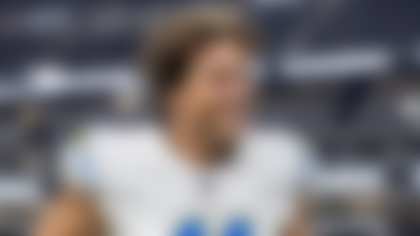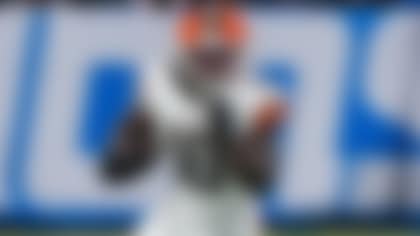With the primary and secondary waves of free agency in the rearview mirror, the NFL world turns its eye almost exclusively to the 2018 NFL Draft. Outside of trades, teams will mostly need to finish their efforts to improve through the college selection process.
While many organizations took steps forward in free agency, every team is left with some number of holes. No one is perfect. Here, we'll look at the fatal flaw remaining for each AFC franchise as we head toward the draft. If not addressed by rookies or internal improvement, these are the issues that could stall hopes for progress when the regular season begins in September.
NOTE: Unless otherwise noted, any advanced metric used in this article comes from the Next Gen Stats tracking data gleaned from the chips embedded within every player's shoulder pads.
Baltimore Ravens: Tight end
The Ravens made some moves to patch up the hole at wide receiver by adding Michael Crabtree and John Brown in free agency. Baltimore will likely add more WR depth, but tight end is even more of a pressing issue, with Nick Boyle and 2015 second-round bust Maxx Williams currently atop the depth chart. Joe Flacco was abysmal on tight-window throws last season, and part of that was not having a tight end he could count on. Baltimore's QB registered a paltry 10.7 passer rating on tight-window throws to Benjamin Watson, while Boyle didn't catch any such targets sent his way. Adding an athletic move tight end who can post up defenders would go a long way toward getting this passing game back on track.
Solution: South Carolina product Hayden Hurst is the No. 1 tight end on both Daniel Jeremiah and Mike Mayock's draft boards, and Baltimore should be one of the many teams interested in athletic marvel Mike Gesicki out of Penn State.
Buffalo Bills: Wide receiver
The easy and obvious answer here is quarterback. The Bills know it, too, which is why they've collected a bounty of picks to move up in next month's NFL draft. When they do acquire that franchise passer, he'll need some more capable bodies to work with. Buffalo currently has Kelvin Benjamin, Zay Jones (who just had a concerning off-field incident) and not much else returning from a wideout group that was wildly ineffective last season. Buffalo's wide receivers averaged just 2.47 yards of separation when the quarterback released the ball last season, the lowest for any receiving corps over the last two years. Their receivers managed a 44.6 percent catch rate when lined up out wide last season, ranking 30th. It would be irresponsible to drop a rookie quarterback into this passing offense as currently constructed.
Solution: It looks like Buffalo wants to sacrifice the 12th and 22nd overall selections to get into the top five picks and scoop up a franchise passer. If the Bills retain picks 53 and 56 in the second round, they could look to find that quarterback a long-term running mate at that point. Someone like Michael Gallup would bring the all-around ability to make contested catches and create the separation this offense needs.
Cincinnati Bengals: Run blocking
The Bengals swapped first-round picks with the Bills in a trade for left tackle Cordy Glenn. If he can get back to his once-dominant form, the mammoth tackle will help the ground game. Still, Cincy shouldn't stop there. Bengals running backs averaged 2.8 yards per carry against loaded boxes last season, ranking 29th in the league and proving far too easy to defend. Cincinnati was especially poor on runs to the outside, not even allowing backs to get to the line of scrimmage (-0.3 yards gained on average) before defenders closed within 1 yard of them. Joe Mixon didn't have the rookie season many expected, but the Bengals need to give him a fair shake with more help up front in 2018.
Solution: The Bengals should spend multiple draft picks on the line and consider taking a center like Billy Price or James Daniels with the 21st overall pick.
Cleveland Browns: No. 2 edge rusher
The lack of a future at the quarterback position beyond Tyrod Taylor is still a glaring issue, but the Browns will solve that with the No. 1 overall pick. After that is where it gets interesting. Cleveland spent last season's No. 1 overall selection on edge rusher Myles Garrett. He was as advertised, leading the team in pressures despite playing just 11 games as a rookie. The rest of the QB hunters on the team were not as productive. Cleveland's edge rushers as a whole posted a 12.5 percent pressure rate in 2017, the lowest mark for any NFL defense. The Browns' D could go from a sieve to a force if they secure another dominant edge defender to team up with Garrett.
Solution: After making the draft's opening selection, the Browns will come back on the clock at No. 4 overall. At least one other team will take a quarterback ahead of them, with a strong possibility two passers go off the board. If so, that will leave Bradley Chubb staring them in the face. Cleveland should pass on the sex appeal of adding a running back like Saquon Barkley and opt for the N.C. State game wrecker.
Denver Broncos: Coverage linebacker
The 2017 Broncos' defense wasn't the same shutdown unit it has been in years past. Most notably, teams could throw on them with more efficiency than usual. Denver allowed the 11th-highest passer rating in the NFL last season. A deep look reveals the secondary wasn't the primary culprit in the slip; rather, it was Denver's middle-of-the-field coverage. Quarterbacks managed a 113.9 passer rating on throws against Denver where a linebacker was the nearest defender. No other linebacking corps gave up a higher rating. This explains why the Broncos annually struggle to cover tight ends. Denver ranked inside the top five in most yards (1,023) and touchdowns (nine) allowed to the position in 2017. John Elway and company are in the middle of reviving their offense, but they can't ignore this leak on the defense.
Solution: There is no reasonable situation to project wherein Denver solves this issue with the fifth overall pick. It's more likely the Broncos spend one of their three Day 2 picks to fortify their middle-of-the-field pass coverage.
Houston Texans: Offensive tackle
The Texans' offense has all the skill-position weapons needed to be a top-10 unit, with Deshaun Watson returning as the field general in 2018. But there's no question this team has a fatal flaw in the offensive tackle position. The Texans allowed a 15.8 percent pressure rate on the right side of their offensive line and 15.7 percent on the left side, ranking 32nd and 31st, respectively, in those categories. The most prominent free agent the team has added in this area is Seantrel Henderson, which is not a solution. With Watson coming back from the second ACL tear of his college/NFL playing career, protecting him is of the utmost importance.
Indianapolis Colts: Skill-position playmakers
The Colts are hoping to finally get Andrew Luck back from a shoulder injury this season. That's great, but when Luck pulls into the driveway of the house he helped build, the yard won't look anything like the well-kept unit he left. An offense once stocked with intriguing talent is stripped down to the bones. T.Y. Hilton is one of the best vertical playmakers in the NFL, but no other Colts player offers much big-play potential. New additions in tight end Eric Ebron and receiver Ryan Grant averaged 5.9 and 7.5 air yards per reception, respectively, last season. Not much vertical ability there. The situation is just bleak in the backfield. Marlon Mack currently sits atop the depth chart, but he was not a consistent runner in 2017. The rookie averaged 2.7 yards per carry on runs where there were an equal amount of defenders to blockers in the box, and just 1.7 when the offense had more blockers than defenders.
Solution: Indy might legitimately get a shot at Saquon Barkley with the sixth overall pick, and he'd be tough to pass up. If the Colts decide to take a marquee defender or guard Quenton Nelson at that spot, they'll have three second-round picks to take swings on playmakers. Chris Ballard could snag a starting running back and an explosive receiver like Equanimeous St. Brown in Round 2.
Jacksonville Jaguars: Big plays in the passing game
Listing quarterback as the fatal flaw for the Jaguars is indicative of just how hard it is to find flaws on this roster. Outside of a top-notch passing game, Jacksonville pretty much has it all. Despite landing a new contract this offseason, Blake Bortles still sits outside the top 20 in guaranteed money at the quarterback position. That deal shows the team does not view him as the engine of the offense or a permanent solution. The coaches' use of him this past season suggests that, as well. Bortles' average completed pass traveled just 16.8 yards of air distance (down the field and not the sideline), which was the lowest of any quarterback with over 200 attempts last year. If this team brought a dynamic passing game to the table, along with a power run game and ravaging defense, it would be unstoppable.
Solution: If Lamar Jackson is somehow available at No. 29 in the draft, he should be an auto pick. Bucky Brooks made that pairing in his March 19th mock draft. The Jaguars wouldn't have to rush Jackson on the field -- let Bortles play ahead of him as the rookie marinates.
Kansas City Chiefs: Front seven
The Chiefs were ousted from the playoffs when Derrick Henry and the Titans barreled through the heart of their defense. The front seven was a weakness in Kansas City all year. The team posted a 35.5 percent disruption rate (percentage of plays with a run stuff or pressure) during the regular season, which ranked dead last in the NFL. Honestly, the team can address any area of the front seven and be justified in doing so. The Chiefs could add to their edge-rushing group, where they have Justin Houston and Dee Ford coming off injury, but little depth behind them. On the interior defensive line, Chris Jones is a good young player, but K.C. managed a 9.0 percent pressure rate from this group, fourth-lowest in 2017. The team might not go after an inside linebacker -- having paid Anthony Hitchens big money to replace Derrick Johnson -- but more depth behind him and Reggie Ragland couldn't hurt. Kansas City's linebackers tackled a running back on just 53.1 percent of the plays where they closed within 1 yard of a ball carrier, ranking 31st in tackle-conversion rate.
Solution: The Chiefs do not own a first-round pick in this year's draft in the wake of the Patrick Mahomes deal, but they have three picks on Day 2. Kansas City should restock its front seven with potential playmakers with at least two of those selections.
Los Angeles Chargers: Interior defensive line
Having perhaps the league's best edge-rushing duo in Joey Bosa and Melvin Ingram goes a long way in covering up this flaw. It's unavoidable to look at the current construction of the Chargers' defense and not come away thinking they need serious help inside. The Bolts were the only team that had two individual players account for more than 25 percent of their team's total pressures. Bosa had the third-highest individual defender share (29.8 percent) and Ingram the seventh-highest (27.1 percent). No other rusher took much of a slice out of the pie. Los Angeles' interior linemen were not effective against the run, either -- the 11.7 percent run-stuff rate ranked dead last at that position. Identifying a big-time presence at defensive tackle would be the key to taking this relatively loaded defense to the next level.
Solution: The Chargers pick at 17th overall in the upcoming draft -- if either of Maurice Hurst (now apparently cleared for action) or Vita Vea gets to that pick, heavy consideration's in order. In his latest mock draft, Lance Zierlein sent them Da'Ron Payne out of Alabama. He believes Payne "can be a dominant run defender with more pass-rush ability than his college production indicates." That is exactly what the Chargers need.
Miami Dolphins: Pass rush
The Dolphins have the makings of a solid pass defense, with intriguing young corners like Xavien Howard and Cordrea Tankersley showing promise. If they are to take the next step, they'll have to beef up the pass rush. Miami totaled just 153 pressures last season -- and that was with the services of now-departed defensive cornerstone Ndamukong Suh. Miami added Robert Quinn in a trade, but at this point in his career, he's not the type of transformative player who can single-handedly boost a rush unit. The lack of pressure on the quarterback was a major reason the team ranked in the bottom five in interceptions and was abused down the field. Miami allowed a 133.0 passer rating on deep passes last season, third-highest in the NFL.
Solution: Now that Maurice Hurst appears in the clear after a medical check flagged a heart condition at the NFL Scouting Combine, he should be squarely on the Dolphins' radar at the 11th overall pick. The brand of interior pressure he brings could be a game-changer for this stop unit.
New England Patriots: Left tackle
The Giants unleashed a mountain of money on Nate Solder's front lawn, causing the Patriots to lose his services. New England's current options at the position include Antonio Garcia, last year's third-round pick who didn't play as a rookie, and LaAdrian Waddle. It's not an ideal situation for a Super Bowl contender. The pass rush didn't bother Tom Brady much in 2017, as he led all quarterbacks with a 98.0 passer rating when pressured. We know Brady can thrive in all circumstances, but there's no reason for the Patriots to force those circumstances on their soon-to-be 41-year-old quarterback. Expect the team to fortify the line in the draft.
Solution: It's always tough to gauge what the offensive tackle options will look like at the tail end of the first round. However, New England should be hoping to snag one at pick No. 31. Charles Davis and Chad Reuter offered up Kolton Miller of UCLA as an option in their latest mock drafts.
New York Jets: Edge rusher
The Jetstraded up to the third overall pick to fix one of their longtime fatal flaws: the lack of a franchise quarterback. But while the lack of an inspiring passer has cast a shadow over this roster, the lack of a credible edge rusher has loomed nearly as large over the last several seasons. In 2017, the average team received a pressure rate of 17.1 percent from its edge defenders. The Jets checked in at 14.4 percent, ranking 26th. Interior defensive lineman Leonard Williams led the team with just 30 pressures. New York will continue to struggle consistently slowing down opposing passing games until it finds a pass rusher who can threaten teams on the edge.
Solution: It will be tough for the Jets to solve this problem in the 2018 NFL Draft. After saying goodbye to their second-round options with the trade up to No. 3, the Jets won't pick again until the 72nd overall pick. New York can target an edge defender there, but unless they really knock it out of the park, they're likely getting a rotational option in Year 1.
Oakland Raiders: Complementary pass rushers
The Raiders added Rashaan Melvin to the cornerback mix coming off a season where he allowed a 66.8 passer rating in coverage. The hope is he and a second-year leap by Gareon Conley will be enough to shore up what was a woeful position for Oakland in 2017. It remains to be seen whether that hope becomes reality, but the front office can help its corners out by beefing up Oakland's pass rush. Khalil Mack is one of the best defenders in the NFL -- and his output is even more amazing when considering how little help he has. Mack collected 31.5 percent of the Raiders' total pressures last season, the second-highest share for an individual defender. Oakland is going to move Bruce Irvin into a position where he'll rush more and drop into coverage less, per Irvin. He could boost his pressure total from 2017 (30) with this move, but more help will be needed.
Solution: Face-of-the-defense type of linebackers in Tremaine Edmunds and Roquan Smith are popular picks for the Raiders at the 10th overall selection in mock drafts. Those guys would help the stop unit, but pairing a rookie pass-rusher with Mack would cause a ripple effect of improvement across the board. A player like Harold Landry, who has really nailed the pre-draft process, should be in consideration, as should Maurice Hurst on the interior.
Pittsburgh Steelers: Inside linebacker
Losing Ryan Shazier to a career-threatening injury took an emotional toll on the Steelers and dealt a crushing blow to their defense. Shazier was playing lights-out football before his 2017 season was cut short. The organization has already stated he won't play in 2018. His absence was noticeable last season and will be again if the Steelers don't identify a replacement. Pittsburgh allowed just 5.2 yards per play when lined up in its base 3-4 defense with Shazier on the field last season -- and 7.1 yards per play in base without him (including playoffs). He left a gaping hole that will need filling for the upcoming season, at the very least.
Solution:Bucky Brooks and Charles Davis both sent Leighton Vander Esch out of Boise State to the Steelers in their latest mock drafts. He would be an option, along with a player like Rashaan Evans out of Alabama. Pittsburgh needs to use a Day 1 or 2 pick at this position.
Tennessee Titans: Edge defender
The Titans got great play out of veteran edge rusher Brian Orakpo once again last season, as he led the team with 21.9 percent of its total pressures. However, Orakpo will turn 32 in July, and 2018 is the final year of his contract. Derrick Morgan and Erik Walden were second and third, respectively, among Titans edge players in pressures; Morgan's 29 years old and Walden's now a 32-year-old free agent. Youth and depth are needed at the position. While pass-rushing prowess will be at the forefront of Tennessee's mind when looking to bolster this position, the Titans should try to identify a player who can also chip in as a run defender. Tennessee had the fourth-lowest stuff rate (13.1 percent) last season from its edge defenders.
Solution: Oddly enough, Tennessee's roster looks rather solid. The Titans were held back by a poorly constructed offense that didn't complement the skills of the talent on the 2017 roster. And they still made the playoffs. With few glaring needs, they should strongly consider spending the No. 25 overall pick on the best available edge rusher.
Follow Matt Harmon on Twitter _@MattHarmonBYB_.












